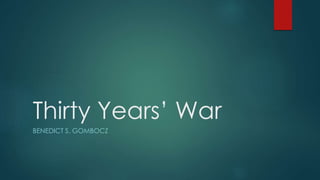
Thirty Years' War: Religious Conflict in Central Europe
- 1. Thirty Years’ War BENEDICT S. GOMBOCZ
- 2. Overview Overview The Thirty Years’ War (1618-1648) started when Holy Roman Emperor Ferdinand II of Bohemia tried to limit the religious activities of his people, leading to revolt among Protestants. The war, fought as a result of religious tensions between Protestants and Catholics, involved Europe’s major powers: Sweden, France, Spain, and Austria, all of which organized campaigns on German territory. Partly known for the massacres for which mercenary soldiers were responsible, the war ended with several treaties, as a result of which was the Peace of Westphalia. The outcome redrew the religious and political map of Central Europe, which gave way for the old consolidated Roman Catholic Empire to create a community of sovereign states. Roman Emperor Ferdinand II of Bohemia
- 3. Origin and causes Origin and causes This war, which changed Central Europe’s religious and political boundaries, had its origins in the Holy Roman Empire, a massive complex of some 1,000 separate, self-governing political entities subject to the rule of the loose suzerainty of the Austrian Habsburgs. A balance of power arose among the leading powers, but throughout the sixteenth century, the Protestant Reformation and the Counter Reformation caused religious division in Germany between Protestant and Catholic groups, both ready to pursue foreign aid to promise legitimacy of a balance of power if there were any need to. Holy Roman Empire
- 4. Outbreak Outbreak Consequently, in 1618, when Ferdinand II, successor apparent to the throne of Bohemia, started to restrict certain religious privileges that his people enjoyed, they instantly demanded assistance to the Protestants in the rest of the Holy Roman Empire and to the leading foreign Protestant nations: Great Britain, the Dutch Republic, and Denmark. Ferdinand called on the German Catholics (led by Bavaria), Spain, and the papacy. During the subsequent struggle, Ferdinand (made Holy Roman Emperor in 1619) and his allies were victorious at White Mountain in 1620 outside Prague, allowing the extirpation of the Protestant faith in in most of the Habsburg entities. In 1621, Ferdinand, motivated by this victory, turned against Bohemia’s Protestant followers in Germany. In spite of assistance from Britain, Denmark, and the Dutch Republic, they also lost; by 1629, imperial armies under Albrecht von Wallenstein invaded much of Protestant Germany and Denmark. Ferdinand subsequently issued the Edict of Restitution, and won back entities of the empire that were under the jurisdiction of the Catholic Church that was obtained and secularized by Protestant rulers. Battle of White Mountain, 1620
- 5. Europe during the war
- 6. Protestant victory and defeat Protestant victory and defeat The Protestant cause could only be saved by Swedish military assistance. King Gustavus Adolphus landed in Germany in 1630; with aid provided by the French government and from several German Protestant entities, he routed the Imperialists at Breitenfeld in 1631 and forced them out of most of Germany. The Protestant revival, meanwhile, endured until 1634, when a Spanish army intervened and defeated the main Swedish field army at Nördlingen, which drove the Protestants away from southern Germany. The Habsburg victory nonetheless provoked the French, who were afraid of being surrounded, to first declare war on Spain in 1635, and on the Emperor in 1636. King Gustavus Adolphus
- 7. Battle of Nördlingen, 1634
- 8. Expansion and end Expansion and end The war, fought in the 1620s only by German states with foreign aid, was now a conflict among the great powers (Sweden, France, Spain, and Austria) mostly fought on German land; for twelve years, armies advanced while battalions (more than five hundred altogether) conducted a “dirty war” to support themselves and to do away with anything of likely advantage to the enemy. Killings, including those mentioned in the novel Simplicissimus by Hans von Grimmelshausen, escalated as troops fought to find proper resources. Finally, the French victory against the Spaniards in 1643 and the Swedes’ victory against the Imperialists at Jankau in 1645 made the Habsburgs make concessions that led to the Peace of Westphalia, which resolved most of the remaining issues, in 1648. The end of the war marked the official end of the Protestant Reformation that began 131 years earlier. Europe in 1648
- 9. Treaty of Westphalia, 1648
- 10. Important consequences The cost was nevertheless huge. Perhaps 20 percent of the total population of Germany died during the war, with casualties of 50 percent alongside a passageway that ran from Pomerania in the Baltic Sea to the Black Forest (Schwarzwald). Villages suffered more casualties than towns, even though towns and cities also dealt a deterioration in their populations, manufacture, and trade. The Thirty Years’ War was the worst disaster to affect Germany until World War II. In contrast, the conflict played a role in putting an end to the era of religious wars. While religious issues remained important after 1648 (for example, in forming an alliance in the 1680s against King Louis XIV of France), no longer did they dictate international alliances. Those German princes, principally Calvinists who fought against Ferdinand II in the 1620s, were in large part inspired by confessional concerns; as long as they governed the Habsburg cause, the issue of religion did as well.
- 11. Important consequences (cont.) But as they were unsuccessful in obtaining a lasting settlement, the task of protecting the “Protestant cause” slowly was assumed by Lutherans, who (if needed) were prepared to ally themselves with Catholic France and Orthodox Russia so that an alliance with the ability to defeat the Habsburgs was possible. Religion’s role in European politics declined after 1630. This was possibly the biggest accomplishment of the Thirty Years’ War because it removed a significant threatening influence in European politics, which both challenged the interior unity of many states and reversed the diplomatic balance of power established during the Renaissance.
- 12. The End Bibliography: http://www.history.com/topics/thirty-years-war http://home.wlu.edu/~patchw/His_101/timeline_wars.htm
